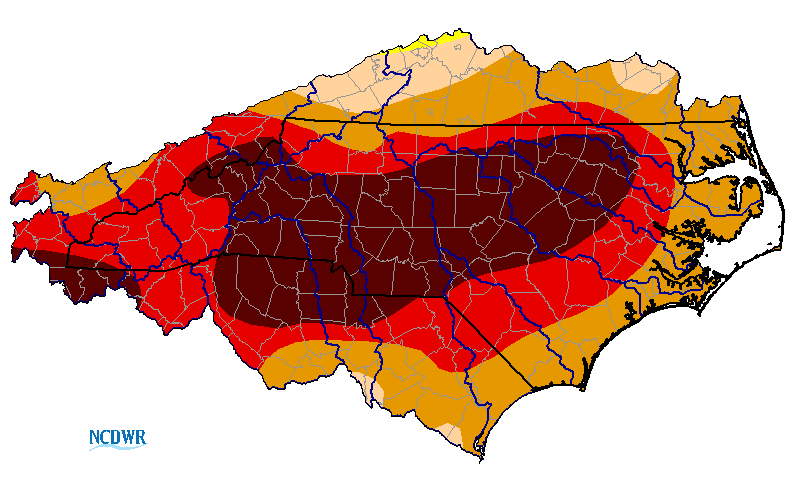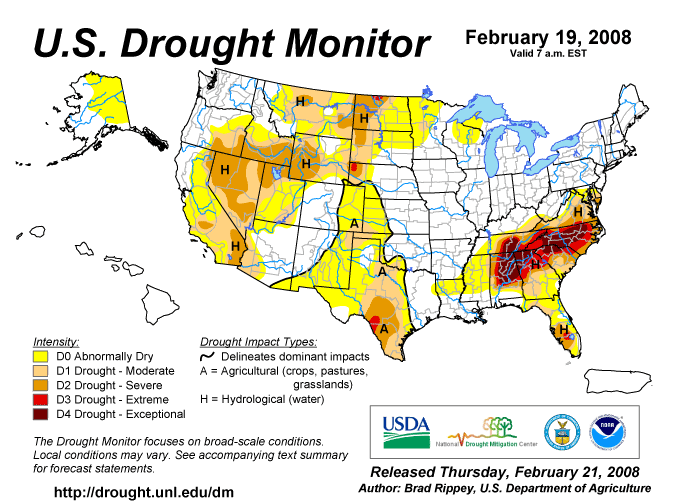
North Carolina is the only state in the country where every part of the state is in a designated Drought condition. Until August ‘07 North Carolina had been spared the worst effects of Southeastern US drought conditions centered on Alabama and spreading into neighboring states, notably Georgia. As of last week, every part of North Carolina was designated as either D2 Drought, Severe, D3 Drought , Extreme or D4 Drought, Exceptional by the USDA Drought Monitor. No part of North Carolina met the criteria for D1 Drought, Moderate. Last week 46% of the state was found to be in D4 Exceptional Drought conditions, a slight decrease from 49% the previous week. Every other state in the country has at least some area designated D0 Abnormally Dry or better. Even if you’ve been living under a rock and have missed the media attention you can’t have failed to notice the drying earth beneath you.
In spite of very recent precipitation (half normal rates) North Carolina is facing a water resource problem that is more than transitory and is compounded by divergent trajectories of supply and demand. Last Saturday a community Water Forum was held in Raleigh at the NCSU McKimmon Center by WakeUP Wake County to address water challenges and to examine the broad range of interrelated issues involved. The Forum was co-sponsored Capital Group Sierra Club, City of Raleigh, NC Conservation Network, Neuse River Foundation, Triangle Community Foundation, UNC Water Resource Research Institute, Wake Audubon, Wake League of Women Voters and several individual sponsors including my wife and myself.
The Forum attended by 250-300 people, including city, county and state leaders, covered a lot of ground focused on Wake County and applicable to the whole state and in turn was covered by a lot of media:
• WTVD: Wake County Forum on Water Woes Draws Hundreds
• WTVD: Hundreds attend water crisis forum
• NBC 17: Group Hosts Meeting To Share Drought Tips
• News 14: Forum asks, "Will the water run out?" (Video)
• Newsobserver: Water woes draw crowd
Some of the presentations have been posted online by WakeUP Wake County:
• Bill Holman (Nicholas Institute for Environmental Policy Solutions (Duke University)
• Mary Brice (Co-Chair, City of Raleigh Water Conservation Task Force)
• Tommy Esqueda (Director Environmental Services Department Wake County Government)
• David Moreau (Director of the Water Resources Research Institute of the University of North Carolina)
While some officials are trying to dismiss long-term water concerns, treating the drought as an anomalous event, they can’t seem to agree whether it is an 800-year or 113-year event. Of course the NC population curve didn’t start its upward climb until about 500 years ago and the only event most people care about is when supply does not meet demand. Raleigh Planning Director Mitch Silver asked, somewhat rhetorically, somewhat defensively, if any city had ever run out of water. Dr David Moreau responded that most municipalities respond to drought before such events occur but did point out that New Orleans during Katrina and eastern NC towns during Floyd lost public water supply due to flooding.
Duke Professor Rob Jackson saw no ambiguity in this drought event. He described the drought as an episodic event caused by elevated temperatures which increased demand, coupled with decreased precipitation to meet that demand. Our normal sources of moisture, the Jet Stream and the Gulf Stream, have been passing us by. He sees the increased intensity of such episodic events as consistent with predictions of global climate change and only sees more of them, without human intervention.
Regardless of the episodic nature of drought events it is clear that at current rates of consumption and current population growth rates North Carolina will approach the limits of safe yield of current and future water supplies. The margin of error for drought events is becoming narrower and NC per capita water use is high relative to other parts of the country. Conservation is essential to future growth and response to drought.
In a telling slide Tommy Esqueda, Director, Wake County Environmental Services compared normal potable water use by Cary households to that of Cary households using reclaimed municipal water for irrigation systems. The increased use by typical households of treated drinking water for outdoor use during summer months (ie lawn irrigation)was clearly visible and clearly a target for reduction or substitution with reclaimed or recycled water.
Due to the drought NC DENR is rapidly expanding the permitting of reclaimed water under current rules. Reclaimed water is treated wastewater effluent that is normally discharged to waterways but, with a little extra treatment, can be used for a variety of non-potable purposes. This is not to be confused with graywater which must be treated before use under current health rules and building codes.
The widespread use of rainwater collection faces some obstacles, though not insurmountable. Under current building codes rainwater can not be used in plumbing systems without separate piping and with some form of treatment, similar to graywater systems. Such rainwater harvesting system exists in the Rashkis Elementary School and Smith Middle School in Chapel Hill and in the new Chapel-Hill Carroboro High School. The new Northern Guilford High School uses treated rainwater for toilet fixture flushing and also uses a “living machine” to treat sanitary waste from which treated effluent is also used for subsurface irrigation of playfields.
Widespread use of these systems will require fine tuning of building codes and economic incentives, such as conservation tax credits or tiered rates for consumption that penalize profligate use of tap water. At the consumer level the obstacles may be more immediate for users who can not afford a $100 rain barrel or the cost for a plumber to install otherwise inexpensive low-flow devices. Municipal water systems will need to figure out how to get through the initial cost barrier ad may need to use rebates in conjunction with increased or tiered consumption rates.
Community well systems run by private companies are not under the control of counties, municipalities or DENR. They are regulated by the NC Utilities Commission and conservation measures can not be mandated without going through the Utilities Commission. DENR regulations require minimum flow rates for wells but there are no maximum limits. Large drawdowns by community well systems can cause the individual wells of neighboring families, businesses and institutions to run dry. This may be addressable as a public health issue if individuals on private wells have no water for sanitation purposes but will have to be addressed through the General Assembly to give counties some measure of control over community water systems.
The Tennessee Valley Authority reported a quarterly loss of $17 million attributed to drought conditions in the South causing a reduction in hydroelectric power generation. One TVA nuclear reactor in Alabama was shut down briefly last summer due to drought conditions. Both nuclear and coal-fired power generation plants depend on copious amounts of water for steam generation and cooling. They require a stable flow of cool water, some of which is lost to evaporation with the balance discharged back downstream from the source with elevated temperatures within an environmentally acceptable range to avoid cooking the ecosystem. Drought can reduce flow, elevate intake temperatures, lower water levels below intakes and reduce the rate of discharge thus limiting the power generation capacity of existing power plants and construction of new plants. Water and power are inextricably linked. In fact an estimated 20% of municipal electricity consumption is used to treat and pump water and wastewater.
Because water doesn’t respect political boundaries many of the solutions to water woes will require regional cooperation at a level that does not currently exist in North Carolina. While some water systems have rudimentary connections to their neighbors the distribution of water at a regional level is haphazard and cumbersome. Regionalism has been suppressed with the decline in Federal funding of regional infrastructure projects and the tug-of-war between the state and local governments over funding and responsibilities. As with transportation the most efficient use of our water resources will come with regional cooperation that avoids a mad scramble to the bottom of the sediment pond.
politics | environment | art
Tuesday, February 26, 2008
Got Drought?
Subscribe to:
Post Comments (Atom)


No comments:
Post a Comment